Author: Gregg Tonkin, Little River Labradors

Normally when one thinks of a fox red Labrador they think of a very dark red. This may be true however it is the shade that makes a fox red and they can appear both medium to dark. In any case, the head and ears should appear red (again medium to dark) and based upon the coat type will determine how dark the body is. Many yellow Labradors have what is called the chinchilla effect where a hair shaft can be totally one color or only a percentage of the guard hair reflects the color. We have had fox red Labradors where only about 20% of the end of the shaft shows the red color. The head and ears were dark but the body looked medium at best and in fact some questioned if indeed they were fox red. One would only need to look close to see the red in the coat versus the dark honey brown of a normal yellow. It is the shade not the degree of darkness that determines if the Labrador is a fox red or not. This "chinchilla effect" can very greatly dog to dog.
Breeders of "true fox reds" will quickly point out that some yellow Labs professed to be "fox-red" are really more dark tan than red and are therefore, not "true fox-reds". The difference in concentration of red color (determined by the "ay" or "as" allele of the A locus) is dependent upon the alleles at the C locus. The "C" allele allows for full expression and intensity of red tones, while the "cch" allele will dilute the red to a clear tan color.
* the underline denotes that the gene locus may be homozygous or heterozygous with a less dominant allele present at the partner-chromosome gene locus
** Labs with this genotype demonstrate the red coloring localized to certain areas of the body.
The "as" allele produces the "saddling effects" seen in many yellows in which there appears darker yellow pigmentation on the back, ears, legs, etc. compared to areas of light yellow on the shoulders, neck, and underside. The "as" allele also increases intensity of phaeomelanin, but restricts its production to the former mentioned areas on the Lab.
The observation that there appears to be no solid fox-red or solid "pseudo" fox-red Labs may be explained by Little's hypothesis that the combination of an "ay" in a homozygous "e" (yellow) dog is lethal. If Little's hypothesis is correct, then this would mean that all fox-red or "pseudo" fox-red Labs must be: as_B_C_ee or as_B_cch_ee, respectively.
****www.labbies.com
Within a litter of fox reds you will always get a variation of shade from medium to dark. Even on breeding fox red to fox red, a variation of shading will result. On all fox red puppies, as they get older, the color will darken and in fact this color change can be dramatic. When one looks at a new puppy on coat shade, it must be remembered that you are looking at undercoat, not the guard hairs. This undercoat will appear to be the color of a brown paper bag. The key again is the head and ears, not the body. Another key on a fox red puppy is the pigment.
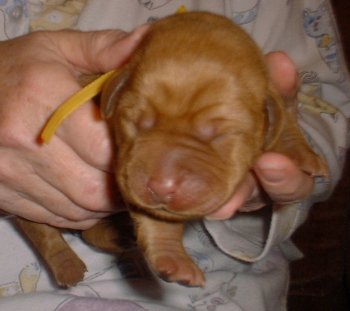
On a normal yellow the pigment will be a distinct pink, on a fox red it will be a peach color.
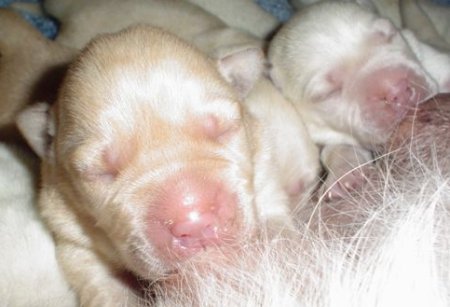 |
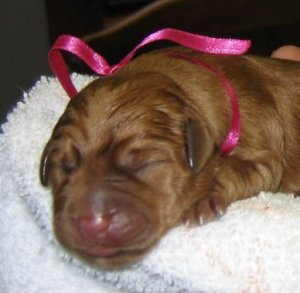 |
Yellow puppy |
Fox Red puppy |
As soon as they are born, they appear fairly dark, within a couple of weeks they lighten up as their undercoat develops. They will stay about the same shade until their guard hairs start to show. It is then the red starts to appear. Again you can get a better idea of their shade looking at the head and ears but only age will reflect the degree of the chinchilla effect on their coat. Even on the head and ears, age will deepen and darken the color.
These pictures reflect how a puppy lightens up just within a couple of weeks, then the chinchilla effect and how it creates shading in the coat. This puppy was the result of a fox red bred to a normal yellow
| A fox red puppy three days old, note the rich solid color at this stage. | 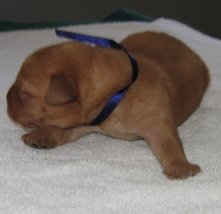 |
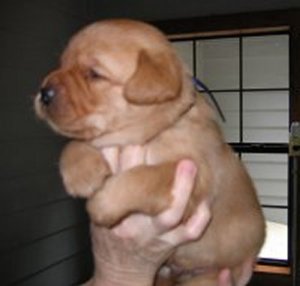 |
The same puppy fifteen days later. Note how he is beginning to lighten up and the "paper bag" color of this undercoat starting to appear. |

The chances of white spots, (chest etc.) are much greater within the fox red shade than normal. This is due to several reasons:
White is very common within the yellow variation of the color. Because the white blends in with the normal yellow shade, it is not seen or noticed therefore ignored. With a red, because it is so dark, the white tends to stand out. In black Labradors, because the gene pool is so large, the tendency to throw white has been largely bred out. To throw white, it takes both parents so in either a black X black litter or black X yellow litter; white spots are not extremely common even though it does happen. In fox reds where the gene pool is so small, one can expect white spots in about half the puppies of the litter.
Below you will see two examples of the very common white seen on fox red Labradors. This can vary from a spot smaller that the ones pictured up to a blaze. There was a particular stunning fox red imported from the UK that had a white blaze, it did not bother him in the Specialty ring and he was used by several in their breeding program irreguardless. In most people's mind, to have a white spot, no matter what the size, is unexceptable for a Labrador even though the Standard excepts it. If you are wanting a fox red Labrador, you must be willing to accept it.
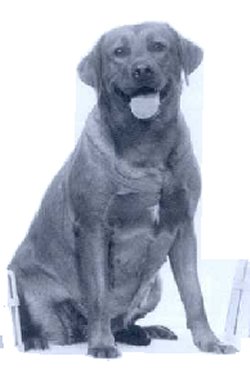 |
 |
Balrion Scarlet Woman |
Oakdale Little River Wildfire |
There is no general difference in personality or health issues on the fox red shade, remember they are just yellow Labradors. It is generally thought that a fox red seems to be somewhat more vocal than normal also a little more Velcro, I believe that is due to the tight gene pool and most are very closely related. At some point in their ancestry there was a vocal Labrador or two. The doubling and tripling of these genes might have set this tendency. It is important to them to be close to their family, they tend not to let you out of their sight. It is then, the vocal aspect shows though. Close to their family, you will never hear a peep. PRA is a health issue to be aware of. A goodly percentage of fox red Labradors are carriers of this genetic eye issue. Genetic research has come up with a test for this condition which considering the frequency of this problem within the shade, at least one parent should be cleared so none of the puppies will ever be effected. This test is designated as the Optigen test where a Labrador will either come back Normal or A (no offspring can ever be effected), Optigen B (carrier), or Optigen C (effected). I feel in this shade the Optigen test is critical. Over the years I have found our fox reds to be orthopedically very sound, more so than the norm.
Most all breeders charge more for their fox red puppies. There are several reasons for this. As one well known breeder who has fox reds mentions on their web site, it is a matter of supply and demand. You can count on one hand the breeders that have fox red puppies that express the proper breed type and temperament. The supply of these puppies does not come close to satisfying those that would like a Labrador of this shade. There is a general thought that a breeder should not charge more for one puppy versus the other based upon shade. Going back to supply and demand, breeders in the Northeast part of the United States will charge a much higher amount than a breeder say in Tennessee. This difference in price is strictly due to supply and demand and the going price of puppies in that area. On a fox red, generally there will be none available within that section of the country so the comparison is made to what other charge even though they might be across the country. While this reason certainly is open for debate, there are other reasons that one can give to think why a higher price is warranted.
- Dealing with the continuing pressure of the families to try
to obtain the darkest puppy in the litter can be frustrating. The breeder
lives with our babies for eight full weeks in our house and get to know the
personality of each baby pretty well. On other litters breeders are able to
match these personalities to their new families for the best fit. On fox red
litters it seems everything gets "thrown out the window" in favor of shade.
On this basis, a breeder cannot satisfy everyone just due to the expected
variation of shade.
- Many of the red puppies are flown to their new homes, either
within our outside of the continental United States. This requires extra expenses
tied to the particular litter.
- Because of travel limitations for the prospective families, breeders tend to keep our fox red litters an additional 1-3 weeks which adds to both care and cost.